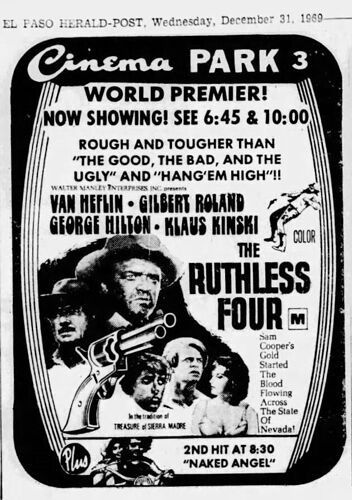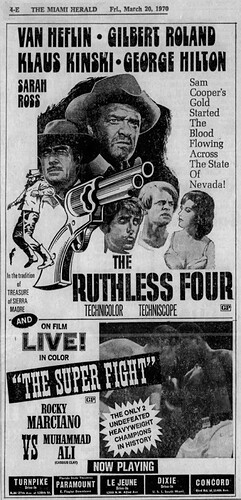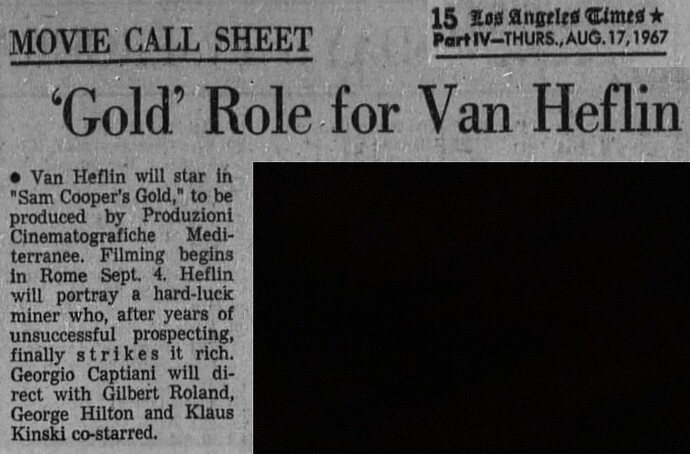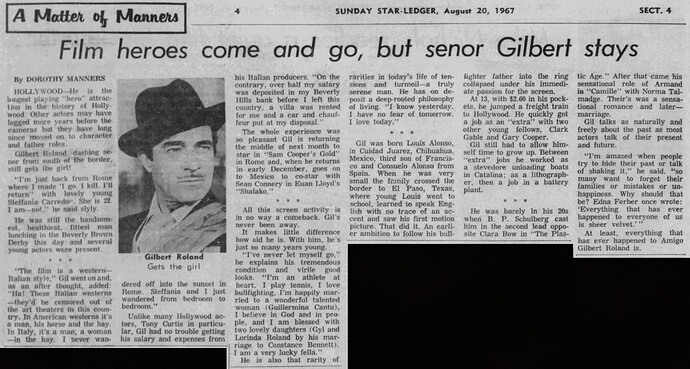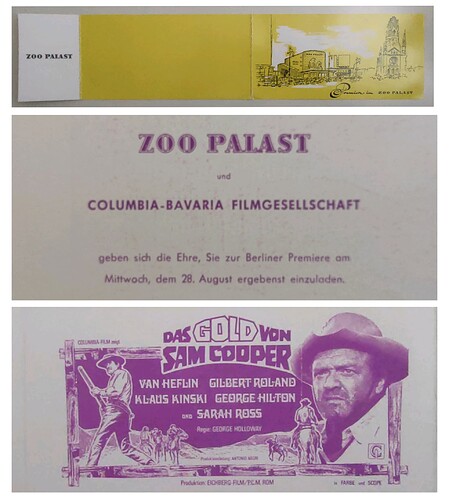Good one, could have been a great one. The set up was very tense and engaging, but later movie sort of starts going through the motions.
I didn’t like Hilton in this one so much, probably because it was obvious he is out of his league in that company. Roland, Kinski and especially Heflin were showing how it is done. One of the best SW cast.
Score was good, if not very spaghettiesque, and added to the atmosphere, but the same theme was a bit overused.
One of the most realistic SWs, nobody shoots the ropes behind the back in this one. Overall above average SW and worth revisiting from time to time.
Until now I’ve only seen copies with French, German or English credits: a remaster from the original negative would be very desirable, so as to recover the cut cigar scene and the full version of the sequence with Mason beating Brent.
Totally agree.
With the death of the Director, Giorgio Capitani, I re-visited this ‘little gem’ last night.
It is dark, but in more ways than one.
There are a few 'Spaghetti Westerns, that have ‘melancholy’ written all over them…this little beauty is definitely one of them.
As for the other melancholic films…‘Find a Place to Die’, with Jeffrey Hunter, springs instantly to mind…
As for ‘Ruthless Four’…? Well, you can’t go wrong with the casting (Gilbert Roland, Van Heflin, Klaus Kinski, George Hilton).
Gilbert Roland is an actor that I could, literally, watch in any film…the man (who began his career in Silent films), has such an aura!
Yep…I love the film!
First viewing: Slow & boring
Second viewing: Enjoyed it
Third viewing: Love this film
Yes top notch this one.
That also sums up my view well after the first warching.
And regarding the homosexual theme between the Kinski and Hilton characters it appears a bit funny, but my favorite in this aspect is Django Kill where one of the bigger baddies and his black clad “muchachos” are having a fiesta and fun with the poor boy Evan accompanied by the suggestive music to surrealistic scenes.
After the 2nd watching I found the 42 first minutes rather slow and boring and not so SW-like, rather more like an American movie. The following hour with the gold adventure is a little bit more interesting but with the repeted Bolero - Lawrence Of Arabia - like mixture music (which is good in itself) even that part gets a non-SW feeling. Only in the last few minutes there is a very nice SW-typical accoustic guitar theme.
I am considering if The Ruthless Four is really worth the 6/10 I initilly rated it as, or should be downgraded to 5/10, in spite of the really good acting.
Since I do not especially look forward to a 3rd view, by my entertainment criterium 5/10 seems more appropriate.
This movie’s page in the SWDb has been updated to the new “SWDb 3.0” format .
Please have a look and let us know if there’s something you can add (information, trivia, links, pictures, etc.).
Apologies for the long break between updating these film pages, got a bit burnt out after doing the first 50. But here’s a new poll for you guys at the top of the page. ![]()
In the English track on the French DVD, Kinski’s character is called 'what sounds like ‘Esidue (Jesus?), the blonde killer’ by the injured Marshal at about 1hr17m. No mention of ‘Brent’. The Italian and French tracks don’t mention a name at all but say he is the assassin who is disguised as a priest.
I find it unlikely this was filmed in 1966. These westerns usually took 5-8m from end of principal photography to release not over a year (release Feb 1968). No reason for a year in post production. It would also make this Gilbert Roland’s first Italian western made before Any Gun Can Play which was filmed in early/Spring 1967 and released in Sept 1967.
but the year delay does not mean post production took that long it might just mean it didn’t get released immediately after it was finished?
But why wouldn’t it get released? Most of these films did not sit very long on the shelf after they were finished. Gemma’s movies hit cinemas very quickly. They had to get them to market quickly to cover the craze and demand. And studio work wouldn’t commence in 1966 before location work anyway? You always do the location work first and the studio work afterwards. Assuming this started in 1966 means that Roland and Hilton made this before Any Gun Can Play which seems implausible. I think this throwaway comment about 1966 is a mistake.
It is far more plausible that this was filmed after Any Gun Can Play probably in the late Spring or early summer of 1967 in the gap between the two Castellari movies that Roland made… Roland then filmed Johnny Hamlet afterwards in the Autumn of 1967.
Really fascinating movie - oddly enough I find the 1st 45 min., where the characters are set up, most compelling. Please bear with my ramblings.
For sure - to state the obvious, the main homosexual relationship is coded as of itself predatory demonic, “deviant”. Kinski’s Blond, pallid, eyes red-rimmed, the preacher in black materializing out of the storm, looks like he’s already auditioning for Herzog’s Nosferatu - the pursuing devil who has his fangs into Manolo, who’s both terrified of him and in the end fatally bound to him.
But this is part of a whole set of wider homosocial links between the guys. Some moments I find interesting:
- Sam to Manolo: “If you want a girl, I’ll get you the best in town.” Non-response from Manolo, instantly swallowed up by hotel room booking dialogue (more below).
- Sam tries to set Manolo up with Annie: “Touch him, he’s lucky.” Camera plunges down to Sarah Ross (Sonja Romanoff)'s sexy cleavage. From whose viewpoint? If Manolo’s, he’s not interested, and hooker or not, she seems embarrassed by Sam’s crassness, even a little creeped out. When Manolo leaves after offhand remark dissing late mother, she follows with “There’s something I don’t like about that kid” - his sexual ambiguity, perhaps, sliding into his moral ambiguity?
- Because hotel is full Manolo shares Sam’s room. Sam wakes up to find other bed empty, and Manolo and Kinski’s Blond plotting in the hallway. He’s shocked to learn that the Blond has been invited along on the closely guarded mission. I am obviously not suggesting that Sam and Manolo are “sleeping together” in any sense other than the most literal (they’re sharing a bedroom). But the setup - suddenly empty bed, Sam’s “jealous” outburst, his sense that he’s being two-timed/“cheated on” - draws his father-figure bond with Manolo into parallel with Blond’s, a guide/mentor figure of a rather different kind,
- which also puts Manolo allegorically between devil (Kinski’s Black Preacher, seducing him from the path) and angel, Sam I guess (a very flawed one - not sure we ever get the past truth of whether he did rat Mason out - who in the end also kills him).
- the Brady bros, and the first major encounter with Mason, happens in, of all gay iconic places, a bathhouse (I couldn’t believe it) with men trotting around in various states of undress.
Yes - with a shriek (“Sam, stop him!”) that as dubbed carries a sort of childish desperation - he’s obsessed with the guy.
Also … I have a mixed response so far to Rusticelli - often I like his post-romantic sound clouds, but have been put off at times by the outright plagiarism. But I really like what he does here - perhaps the big tunes are lush for the arid background, but they suggest the yearnings of a bunch of (again) obsessed people.
Loved the end. Sam’s goldlust is almost aesthetic - less greed for what gold can do than a belief that the moment of its finding is “the most beautiful thing in the world”. But the story confirms what he knew at the outset: the prospector can’t trust anyone, because that’s not in the nature of the game and the people who take part. So after a set of fragile relationships - a long-lost foster-son, a former comrade he may have double-crossed - he’s left, in the final shot, alone.
Excellent if perhaps not eminent - a firm 7/10 for me.
‘The Ruthless Four’ opened in El Paso on December 31 1969, although there were advance screenings at air base theaters in Texas and New Hampshire earlier in the month.
What a review!
“All the shooting was done in Italy and Germany - And looks it, in fact you can almost hear yodeling in the distance.”
WRONG! … all filmed on location in our beloved Almeria, and it looks beautiful too.
Well, if you’re a drunken hack, I suppose you can imagine anything, to make yourself sound witty and disparaging.
![]()
An interview (below) with Gilbert Roland a few weeks before returning to Rome to star in ‘Sam Cooper’s Gold’.
Title changed HOLLYWOOD (UPI) - The title of Van Heflin’s new film has been changed from “Sam Cooper’s Gold” to “Each Man for Himself.” (Austin American Statesman, February 11, 1968)
Article on Gilbert Roland says he was going to be in Shalako after Sam Cooper’s Gold co-starring with Sean Connery. Presumably, he would have played the Stephen Boyd role. Wonder why that fell through.
I can’t imagine him in any of the key roles in this film … and I’m certainly glad he didn’t get cast … it would have rendered it unwatchable for me.
![]()
The Berlin premiere for “The Ruthless Four” took place on August 28, 1968. Here are some photos of an invitation card to the film premiere at the Zoo Palast Berlin.
Oh wow the Zoo Palast ![]() now an upscale Theater with 70mm capability that wouldnt show an old Spagetti western
now an upscale Theater with 70mm capability that wouldnt show an old Spagetti western
